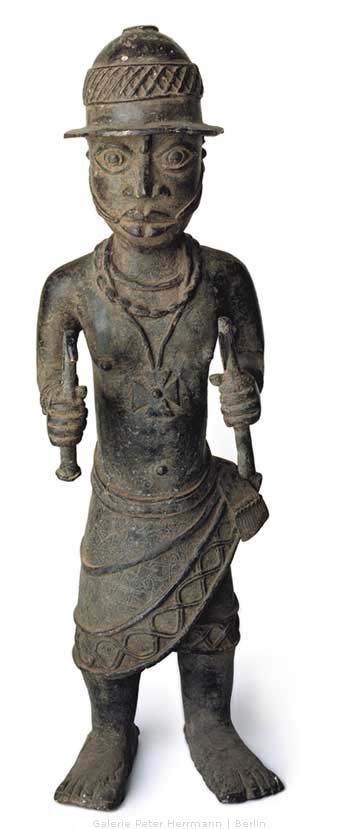Galerie Peter Herrmann |
- | Ancient Art from Africa |
||
 |
| Ewua-Dignitary | Thermoluminescence-Report |
All objects of comparison feature certain shared elements: a cross on the chest, cat's-whiskers scars at the corners of the mouth and a hat, though clothing and hand-held items vary from object to object. Our figure wears only a loincloth, his unclothed upper body decorated with a cross and two additional necklaces. In his right hand, he holds a hook or curved rod and in his left hand, a type of axe or hammer. Stylistically, this work can be clearly associated with Benin, though the cat's-whiskers scars and cross are uncommon attributes. The scars in particular indicate that the figure depicted is a foreigner or even a slave. But who was this person and why was a non-native (if it is, in fact, a non-native) deemed worthy of representation? Cat's-whiskers scars are common amongst certain ethnic groups, including the Nupe, who live north of Yoruba. They also appear on old Ife terracottas, a fact which has lead Frank Willett to hypothesize that an object like this one could represent an Ife person who acted as messenger between the two royal cities. This theory is supported by the late 15 th -century account of a Portuguese person, who describes a messenger of the king bringing the emblems of authority (hat, chest cross, staff) from Ife to Benin so that they could be used to affirm the new king. After completing the mission, the messenger, a slave, supposedly received a cross himself as a sign of his newly-granted freedom. As early as 1919, Felix von Luschan tried to establish that this figure could depict a king with the sobriquet "Panther." According to Luschan, the cat's whiskers have no real pictorial value and should thus instead be interpreted as purely symbolic. He sees the cross hanging around the neck as a Christ-medal given by the Portuguese. That theory is by now obsolete and, as such, barely still discussed. The newer research (Paula Ben-Amos, e.g.) offers a totally different interpretation of this figure - namely, that it depicts either a priest of Osanobua, the god of creation, or a member of the secret society, "Ewua association," both of whom would have worn a cross at the palace. According to this interpretation, the cross is a cosmogonic symbol that acts as a sign of the creation of the world. |
| Similar objects | Illustration |
Nationalmuseum Lagos |
Ekpo EYO, Frank Willett: Kunstschätze aus Alt-Nigeria, Mainz 1983, S. 139. |
|
Frank WILLETT: Ife. Metropole afrikanischer Kunst, Bergisch Gladbach 1967, S. 37. |
Liverpool Museums, Liverpool |
Elsy LEUZINGER: Die Kunst von Schwarz-Afrika, Recklinghausen 1972, S. 166. |
William B. FAGG: Bildwerke aus Nigeria, München 1963, Abb. 63. |
Völkerkundemuseum, Dresden |
Felix von LUSCHAN: Die Altertümer von Benin, Band 1, Berlin 1919, S. 290. |
Ethnologisches Museum, Staatliche Museen zu Berlin |
Felix von LUSCHAN: Die Altertümer von Benin, Band 3, Berlin 1919, Tafel 68. |
The University of Pennsylvania Museum |
Paula Girshick BEN-AMOS: The art of Benin, London 1995, S. 56. |
Slg. A. Maschmann |
Armand DUCHATEAU: Benin. Kunst einer afrikanischen Königskultur, München 1995, S. 77. |
General Pitt Rivers's Museum at Farnham, Dorset |
Augustus Henry PITT-RIVERS: Antique Works of Art from Benin, London 1900 (Reprint 1971), S. 31. |
Trustees of the National Museums Scotland, Edinburgh |
Barbara PLANKENSTEINER (Hg.): Benin. Könige und Rituale. Höfische Kunst aus Nigeria, Wien 2007, S. 333. |
